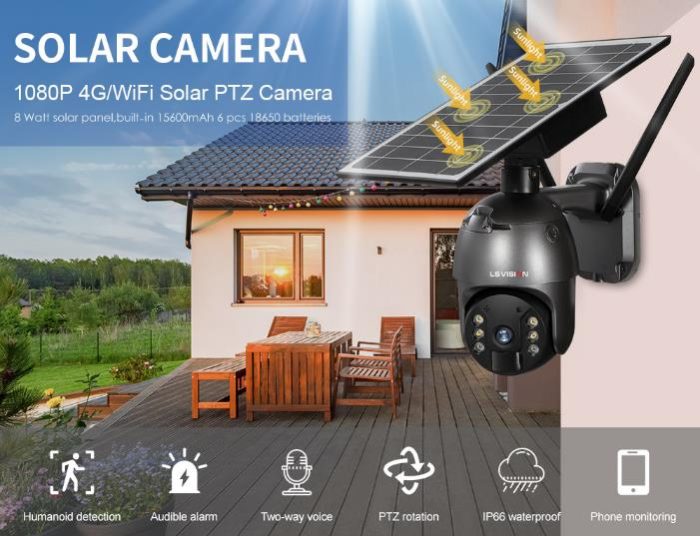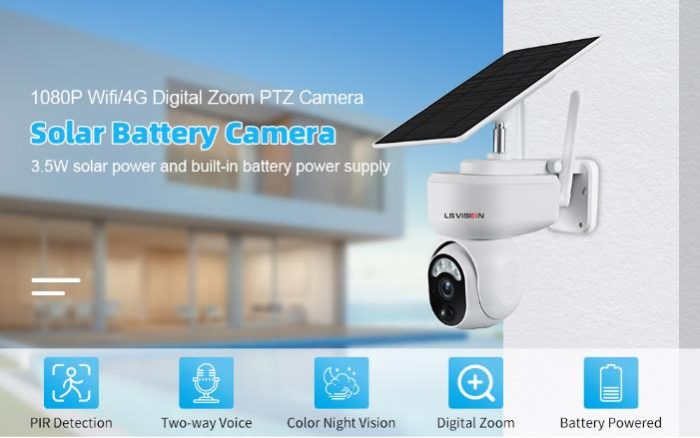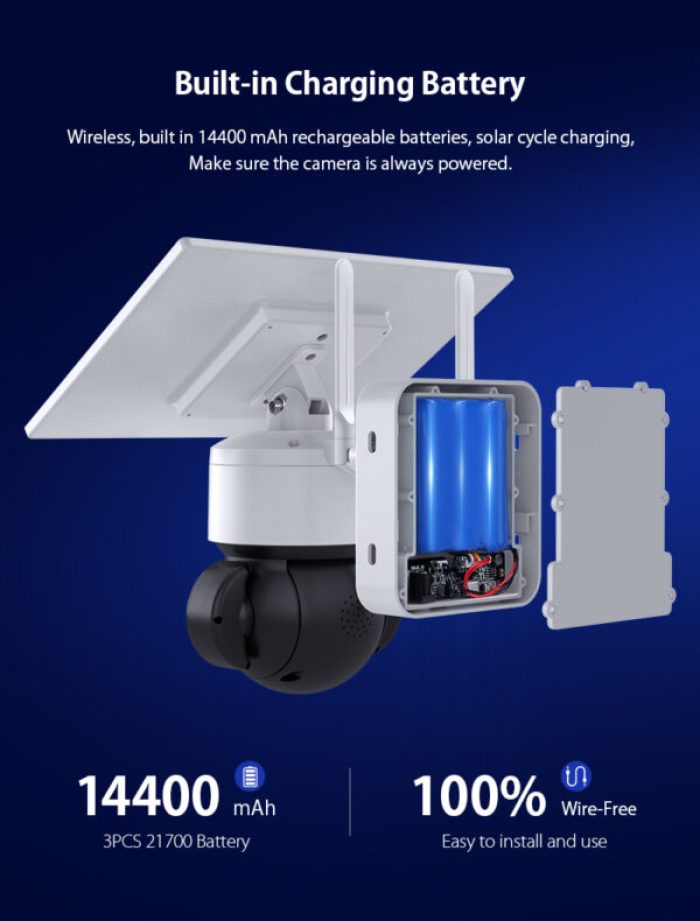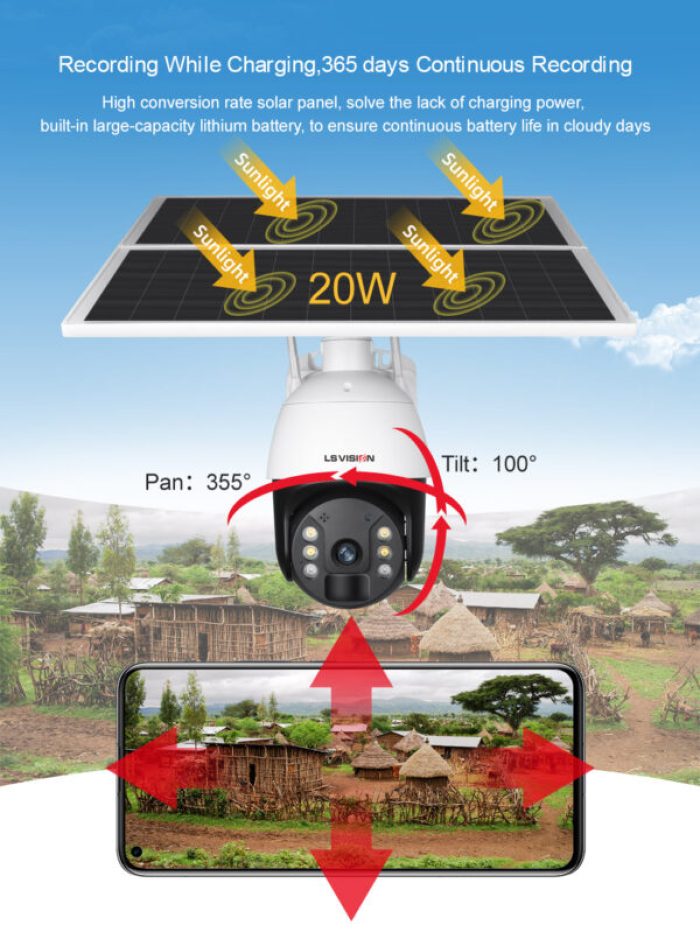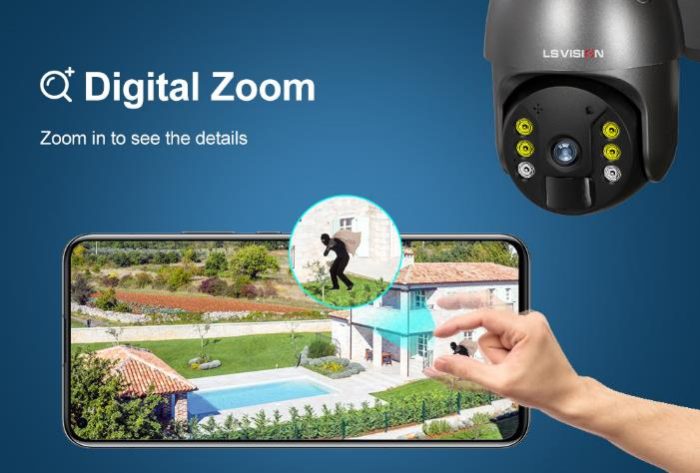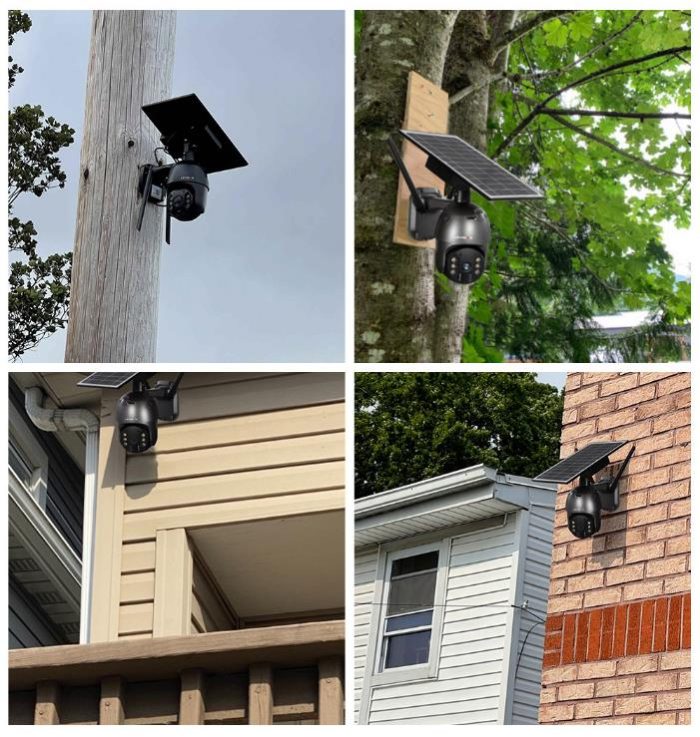How to ensure a longer service life of solar cameras?
The most important thing is to choose a solar camera with a large battery capacity, the battery capacity of a solar security camera determines how long the camera can operate without sunlight. The best solar-powered security cameras come with batteries that provide at least 12 hours of power, even without the sun.
Usually, the camera is equipped with 6 18650 batteries, and the battery capacity is at least 21700mAh, which can ensure that the battery can supply power for up to 3 days on cloudy and rainy days without light. If you live in a year-round sunny area, battery choice isn’t the most important thing to you. Longer-lasting rechargeable batteries are essential if you live in an area that doesn’t get a lot of sunlight for part of the year.
How Do Solar-powered Security Cameras Work?
The first question asked by many first-time buyers is how do solar-powered security cameras work? Solar-powered security cameras rely on small solar The first question many first-time camera buyers ask is how do solar security cameras work? In fact, solar-powered security cameras rely on small solar panels to convert sunlight into electricity, which then charges the rechargeable battery built into the camera. Integrated inverters in security cameras can also convert direct current (DC) power from the solar panels to alternating current (AC) power to provide power when the sun is out. Storing power from the built-in battery during the day keeps the solar-powered security camera working at night.
How to reduce the delay between the trigger (motion detection) and recording?
Pls kindly note that if there is no PIR detection, the camera will be in standby mode for saving power, once there are any PIR activities, the camera needs time to activate itself, upload the data to the server, and download that data to your cellphone.
Generally speaking, there will be a 3-6s delay, when the motion is too fast or short, your camera might not have a chance to capture it, appreciate your understanding.
If the Wi-Fi signal is weak, your camera will take a much longer time to be activated and upload/download the data to the server, pls ensure your camera is connected with a strong and stable Wi-Fi signal.
4G Solar Cameras FAQ and Solutions
How long does it take for a solar camera to be fully charged?
If the solar camera is working under good weather conditions with efficient sunlight and fits the working temperature and humidity standard, it can be fully charged at least 8 hours of direct sunlight. If your installation area is often cloudy or rainy or snowy, this may limit the amount of sunlight your solar device receives. It is recommended to choose a location that can receive the most sunlight during installation
What I could do to improve my wifi signal on the wifi battery camera?
For the wifi battery camera, the max WIFI range it’s around 30-60 ft, the best WIFI range is 30 ft.
If the place you want to install the wifi battery camera is too far away from your router, the wifi signal might be weak. But you can use the WIFI extender to strengthen the wifi network.
Below are a handful of tips to help you improve and optimize your home wireless network speed.
1). Location of Your Router Matters.
2). Overcome Interference & Find the Right Wireless Channel.
3). Use Wi-Fi Extenders to Boost Your Range.
4). Make Sure Your Firmware is Up-to-Date.
5). Secure Your Wi-Fi Connection.
How long can a solar camera be used without sunlight with a full charge?
The solar camera of the low-power type uses the PIR motion detection function. Only the detected person will trigger to start working, and it will be in a sleep state at other times. Under normal circumstances, the camera can continue to work for a long time in the absence of sunlight, depending on the number of triggers. A fully charged solar camera battery can typically provide 5 to 7 days without sunlight, assuming the camera works 24 hours a day.
In addition, the total capacity of the battery will also affect the duration of the charge. It depends on the type of battery.
Sometimes the battery is drained quickly, probably by leaving the app open all day/night to drain the battery. So as long as you regularly check for notifications or other notifications, the battery will never go away. As long as the number of triggers is small, almost no power is consumed overnight.
Why are more and more people choosing solar-powered security cameras?
The solar 3G 4G camera surveillance system is a major breakthrough in the camera industry. It breaks the limitation that traditional cameras need a network and main power for data transmission. Using mobile phone mobile networks to transmit video data and solar energy to supply electricity, solar 3G 4G camera solves the monitoring problem in areas without grid and electricity.
The working principle of 3G/4G cameras is similar to that of mobile phones: the video data is sent to the server through the base station through the built-in 4G module. Therefore, in order to transmit data, the 3G/4G camera needs to be inserted into the SIM card like the mobile phone.
The working principle of the solar power generation system is to generate electricity through the solar panel and store it in the battery, so as to ensure that the camera can continue to work at night without light and on cloudy and rainy days.
Remote (and geographically challenging) areas may not have electricity and wireless networks, but they still need the same security. In fact, these locations are more difficult to secure because they don’t have that access—thieves know it. In order to reduce your losses, it is recommended that you first understand the solar camera to see if it is suitable to escort your safety.
Benefits of Off Grid Solar Powered Security Cameras
1. Solar security cameras allow flexible positions
Solar security cameras do not require cables and grids to work. Therefore, it can be used in various monitoring applications, such as remote sites or geographically challenging environments.
Typical locations where you can install solar surveillance cameras include, but are not limited to, your vacation home, shed, construction site, vineyard, farm, barn, boat, warehouse, RV, and more.
2. Easy to install and move
Solar powered wireless security cameras can be quickly installed anywhere you want, and since you don’t need to run any messy cables or drill holes, it’s a very cost-effective security option.
Even better, you can easily move solar security cameras as projects progress or are complete, such as construction sites or new hoses under construction, and bring the solar IP cameras to new locations.
Solar security cameras are highly portable and flexible, requiring no wires, no wiring, and no drilling. You can place it indoors and outdoors wherever you like, such as your front door, backyard, nursery, temporary work sites, and more.
3. Environmentally friendly
Solar-powered security cameras are powered by renewable sunlight and do not damage the environment or cause any pollution like waste and disposable batteries.
What’s more, creating the infrastructure to support traditional surveillance systems can be disruptive. Solar-powered surveillance cameras require no infrastructure and can protect areas such as wetlands. This is an eco-smart solution as it requires no electricity and runs on renewable energy. It also requires minimal infrastructure requirements so the surrounding natural environment can remain the same.
4. Solar powered cameras provide day and night surveillance
Solar-powered wireless security IP cameras can be powered by rechargeable batteries at night when there is no sunlight.
Some solar security cameras are equipped with starlight sensors that can provide brilliant color night vision – a huge leap compared to other security cameras.
5. Easy to expand
Solar security cameras are also a flexible and scalable solution if you want to add 2 or 3 cameras later. With Security Camera Viewer, you can also watch live views of multiple solar IP cameras simultaneously on your smartphone. If you need to add or remove security cameras, it’s easy to do so with a solar system. Whether you’re powering an entire site or a single room, solar power can help you do just that. You can group cameras and combine real-time information into one secure login where you can access all footage.
6. Solar security cameras have a long service life
Most solar panel manufacturers offer more than 10 years warranty, which means that solar panels used in security cameras can still produce no less than 80% of their power after 10 years, with little or no maintenance.
7. High privacy and security
Compared with the traditional camera transmitted through the Internet, the signal transmission through the mobile phone network is more secure, and it is more difficult for hackers to break into the camera system
8. No power supply required
No electricity is required, and the system can include battery backup to ensure that when there is not enough sunlight for a period of time, you will always have power, even if there is a power outage in your area. The rechargeable battery retains enough power to keep the camera running, even in foggy weather. Most solar panels are sturdy enough to catch small rays on low-light days. Don’t worry about power outages!
9. Cloud Control
You can install solar safety systems anywhere – they work efficiently wherever you install them.
If you live in a remote area with electrical connectivity issues, these systems will work perfectly. When a camera needs to be adjusted, technicians don’t need to be on-site because they can make adjustments from a remote location via the cloud. Today, most of these cameras are equipped with Wi-Fi, which makes them easy to monitor and operate from any remote location. If you’re on vacation, you can adjust camera settings and monitor your home with confidence.
10. Intelligent Analysis
The system can send notifications to employees in various situations, such as the detection of an intruder or unusual activity.
11. Waterproof and moisture-proof
Since the purpose of installing solar security cameras is to consistently perform and overcome any situation caused by nature outdoors, LS Vision’s solar cameras feature ip66 weather protection against snow, rain, dust, and direct sunlight to protect your property all year round.
Home solar systems have many advantages. The main benefit is reduced carbon emissions and lower bills. After installing solar security cameras, you can move on to installing solar security lights, solar security sirens, and other solar systems. This way, not only will your bills be affordable, but you’ll also be doing your part in reducing global warming.
What to Consider When Buying a Solar Security Camera?
Solar powered security cameras, with self-renewal and clean energy, are gaining popularity as the public becomes more environmentally conscious. The initial investment in buying one of the best quality solar security cameras can be huge, but as the life of the solar panels increases and more solar security cameras are installed, the future benefits will definitely be worth it. In your process of choosing the best solar security camera, here are some key factors that you absolutely cannot miss.
1. Solar panel capacity of solar security camera
The amount of electricity that a solar panel in a solar security camera can generate is determined by a variety of factors, such as the average amount of sunlight, weather conditions, the tilt angle of the panels, and more.
The solar panels that come with the security camera should generate enough power to power the camera for 8 hours a day. At the same time, it should also be able to have a fully charged battery.
To ensure the efficiency of the solar panel is at its best, make sure that nothing is blocking the direct sunlight from the solar panel. If you are in the northern hemisphere, orient the PV panels due south; if you are in the southern hemisphere, orient the PV panels due north for maximum natural resources.
Weather conditions like snow and dark clouds can reduce the efficiency of a solar panel, so giving it the best possible angle will help.
Also keep your solar security camera’s panel clear of possible obstructions, such as shadows from nearby trees or shrubs.
In addition, it can improve the performance of the security camera by regularly wiping the surface of the solar panel with a damp paper towel or cloth to remove dust or debris.
2. How much battery does your solar security camera need
These rechargeable batteries can power your solar-powered security camera in low sunlight.
Solar security cameras should be equipped with rechargeable batteries to power the camera when the sun is low. The capacity of the battery should be at least 10 times the maximum output capacity of the solar panel. Otherwise, the battery may be damaged by overcharging.
The average charging time is about 6 to 8 hours. This stored power should last from 1 week to 3+ months without additional charging. Of course, it is possible that only the camera is actively recording when the motion detector is triggered or when the user is connected to the camera.
The storage capacity of a battery is measured in milliamp hours or milliamp hours. The more features a camera has that require power (such as two-way audio, Wi-Fi connectivity, and night vision), the more battery capacity it will require.
A shortcut to choosing a battery for your solar security camera is to buy a solar IP camera with a rechargeable battery.
If you want to add a battery backup to your solar security camera, you can ask the seller of the solar camera directly for recommended models.
3. Where will the solar security camera save the video
If you prefer to record motion-activated video locally without charging a subscription fee, a solar powered security camera with an SD card might be a good option.
You can also easily playback and manage video from wireless solar surveillance cameras via the phone’s motion sensor stored on the memory card.
If you prefer to access your data anywhere on your mobile device with an internet connection then opt for a cloud service and you can access your data anywhere on your mobile device with an internet connection. The footage of the wireless solar security camera with motion sensor can be Save on your phone’s SD card.
4. Data Transmission Of The Solar Security Camera
WiFi solar security cameras with motion sensors can send instant alerts when the network is connected. You can also watch solar wireless home security cameras live through the APP on your smartphone.
If there is no network in the monitored place, don’t worry!
Solar security camera with SD card (slot) can still record motion sensing events even without WiFi/Internet.
But if you want to watch your wireless solar security camera live or receive instant alerts, an internet connection is a must.
Thanks to the introduction of solar-powered cellular security cameras, they can operate on 3g/4G cellular data and work where there is no hardwired internet or WiFi, like 4g solar-powered security cameras.
Any feature of a wireless solar security camera you can find in a solar cellular security camera.
5. Image Resolution of Solar Security Camera Lenses
Resolution refers to the sharpness of an image. If the lenses aren’t sharp enough that you can’t see individual faces, these lenses are useless.
Preferably between 720p to 1080p resolution, although there are higher resolution cameras. 720P resolution is common in low-end and budget models. 1080P resolution is standard for most solar cells.
6. Cost of Wireless Solar Security Cameras
The initial investment in buying the best quality solar CCTV security cameras can be large, but as the life of the solar panels increases and more solar security cameras are installed, the future benefits will definitely outweigh the costs.
So instead of opting for a fake solar security camera or a cheap solar IP camera with a low resolution, choose a high-quality solar security camera from a trusted brand.
Quick tip: When you’re looking for a wireless solar-powered outdoor security camera, make sure it’s at least Full HD (1080p) for recognizable detail.
7. Design and waterproof performance of solar security camera
According to the shape and design, it is divided into two categories: bullet type and dome type.
a. Bullet-type surveillance cameras
Bullet-type, they have a fixed field of view with a wide field of view that can be adjusted manually or via a remote control. Bullet-shaped security cameras are often used at entrances. They usually include motion sensing and night vision.
b. Dome security camera
Their field of view is usually smaller. Their swivel angle is close to 360 degrees, which makes them a great choice in commercial and industrial settings. They are also sometimes used in residential environments, although dome cameras designed for the home are generally not as robust as those designed for commercial and industrial applications.
The waterproof rating can tell you how well your camera will work outdoors. It is represented as IPXX. IP stands for Ingress Protection. The first x represents resistance to debris, ranging from larger solid objects, like leaves, to tiny solid objects, like dust.
The second x represents the resistance to water, which can be zero resistance, or a prolonged immersion in several feet of water with no effect. A rating of 5 will ensure the camera doesn’t shut down in heavy rain.
8. Solar security camera compatibility with existing infrastructure
Your existing Wi-Fi, smart home or 4G service provider should be compatible with solar powered security cameras. While most products will work with any type of Wi-Fi, the ability to connect directly via a built-in 3g or 4g network and the ability to integrate with your smart home needs to be checked for security cameras to work properly.
9. Communicate via Solar Security Cameras
Some models allow you to have two-way intercom with the person on the other end via the built-in microphone and on-camera speaker. For this feature to work, find out the optimal working distance and height before purchasing or installing.
10. Motion Detection and Night Vision Capabilities Of Solar Security Cameras
PIR motion sensing is an advanced feature that uses computer algorithms to differentiate between human and non-human images. If the target is not a person, the motion detection system will not sound the alarm. Night vision capability is very useful if you want solar powered security cameras to work at night or in dark places.
Summarize
Running a few surveillance cameras 24/7,365 days a year can add a lot to utility bills. Using solar energy can save a lot of energy. This is why solar-powered security cameras are becoming more and more popular.
Besides reducing utility bills, they have a long list of other benefits and useful features over wired and battery-powered security cameras. In 2021, the performance of the solar version has already caught up with the conventional power version.
